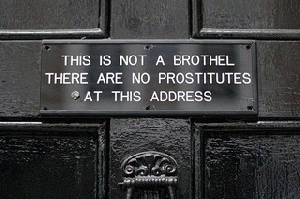Over the past several years, a farrago of articles has made claims to debunking the "myths" of sex trafficking and prostitution. These articles concentrate on several themes: rhetorically deriding accounts of sexually exploited women as sensational that create "moral panics;" discrediting the words, lives and efforts of those who identify as survivors of prostitution and sex trafficking; damning the rescue of prostituted and trafficked women and children by over-zealous NGOs; and disputing the numbers of women and girls sexually exploited during sports events such as the World Cup, Olympics and Super Bowl.
A coterie of writers has been moved especially to critique laws that penalize the demand for prostitution, making it illegal to purchase sexual activities. One recent piece illustrates how "evidence" is always mediated by interpretation and by selecting certain examples at the expense of others.
In The New York Times (1/20/15), Canadian op-ed contributor Julie Kaye attacks Canada's new prostitution law blaming Canada for following a "flawed" Nordic Model penalizing the prostitution users, which has been passed in Sweden, Norway, Iceland, and to a modified extent, in Finland. Kaye bases her "evidence" on one country -- New Zealand -- to tout the benefits of decriminalizing and regulating prostitution. Had she represented the range of countries that have done so, the picture would have looked much different.
In the year 2000, the Netherlands struck pimping and brothels from the criminal code and set up "safe tolerance zones" in major cities where men could buy women in prostitution legally. From 2003-2009, Amsterdam, Rotterdam and other municipalities shuttered these zones because they quickly became unsafe and sordid places for prostituted women where organized crime operated with impunity. During 2007-08, Amsterdam also closed down 1/3 of its legal window brothels because a National Police investigation concluded that the Dutch prostitution system was out of control.
Germany decriminalized aspects of its prostitution system in 2002. Two years after the law was passed, the number of persons in prostitution rose from about 200,000 to over 400,000 -- mostly women who come from foreign countries. In its evaluation of the 2002 German Prostitution Act, an official federal ministry report acknowledged the law has not made "actual, measureable improvements to prostitutes' social protection."
In the state of Victoria, Australia, legalization has fostered intense growth in the illegal sector. As early as 1998-1999, four years after full legalization of prostitution in Victoria, unlicensed brothels there tripled in number. The pimp of yesterday has become the legitimate sex entrepreneur of today who benefits from an ever-expanding sex industry that powers a major part of the state's economy.
Kaye's poster country for decriminalization of the sex industry is New Zealand. However in 2013, former New Zealand women in prostitution appeared before a parliamentary committee and stated the 2003 Prostitution Reform Act (PRA) had failed them and others who remain in the industry. They claimed decriminalizing the sex industry "has simply played into the hands of the pimps and brothel owners and enabled them to gain a faà �ade of respectability while legally preying on the women they control." Police association president Greg O'Connor has reported that decriminalization in New Zealand has made gangs and organized crime flourish, laundering money through legitimate businesses.
(Note: You can view every article as one long page if you sign up as an Advocate Member, or higher).





